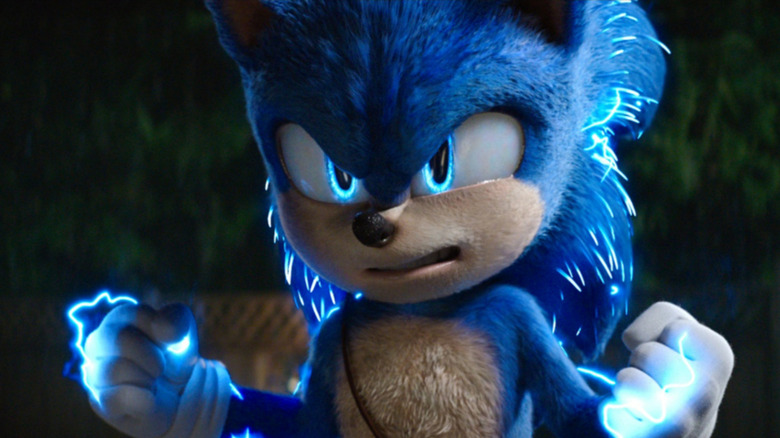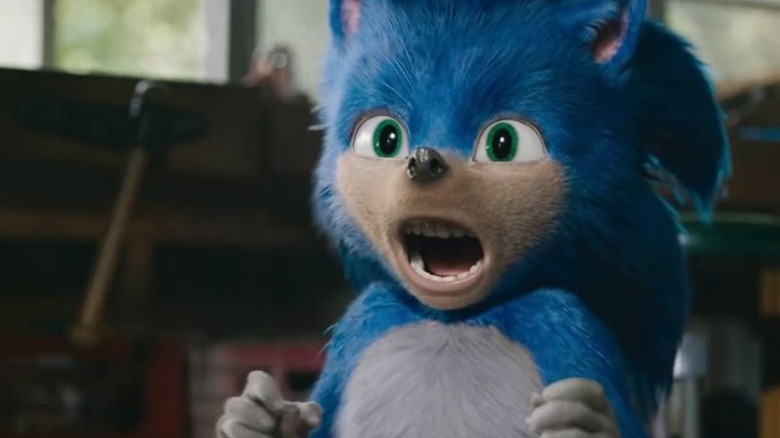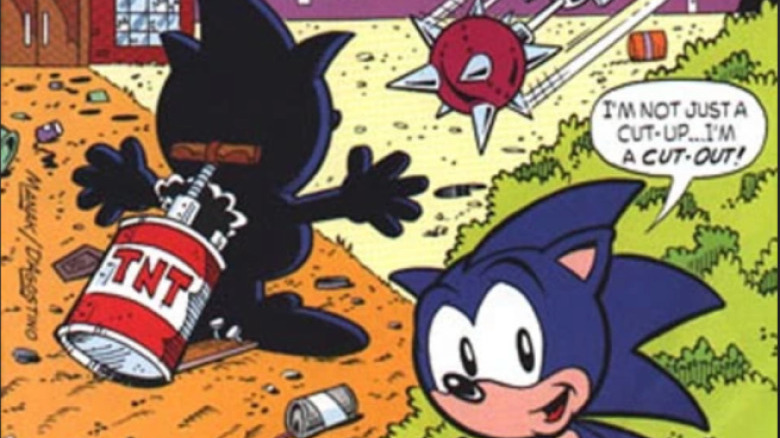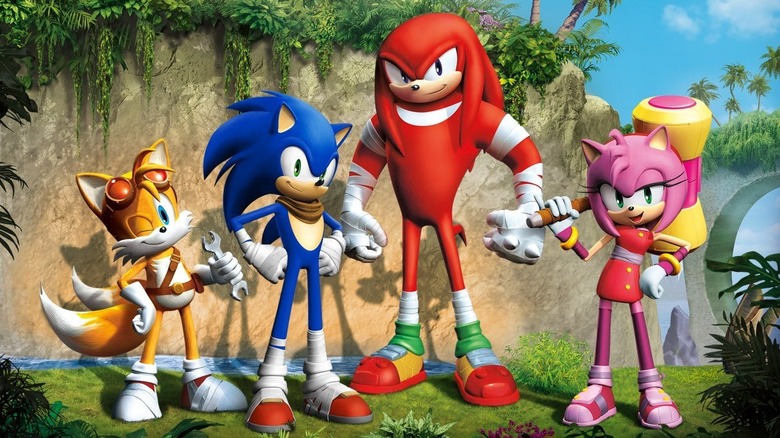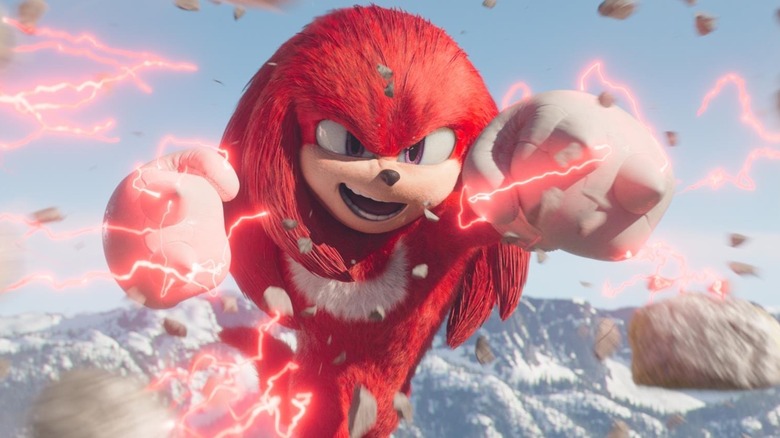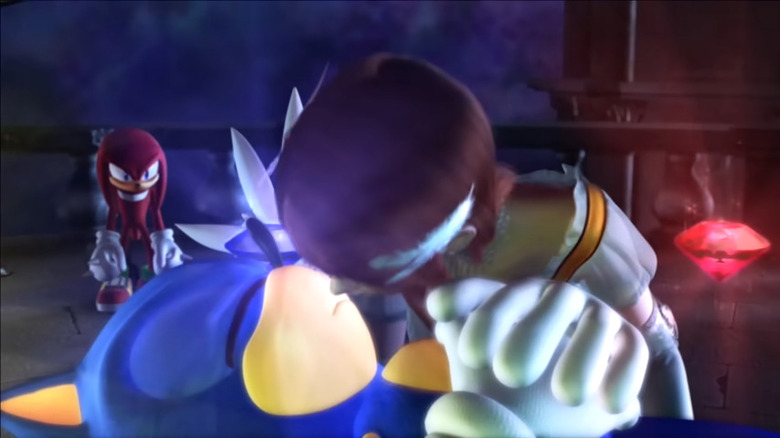The 5 Biggest Controversies In The Sonic Franchise
"Sonic the Hedgehog" is one of the most iconic video game franchises in history. The property centers on the titular Sonic, an anthropomorphic blue hedgehog with superspeed (just like real hedgehogs, of course) who battles the evil scientist Doctor Eggman. Created by Japanese developers Yuji Naka, Naoto Ohshima, and Hirokazu Yasuhara, Sonic debuted in 1991 on the Sega Genesis and gave the company a mascot that could compete with Nintendo's Mario. Quickly, Sonic became a worldwide phenomenon, helping Sega become a major player in the console wars of the early 1990s and even becoming the first video game character to get a balloon in the Macy's Thanksgiving Day Parade in 1993.
The media franchise has since expanded far beyond video games, with Sonic starring in his own comic book series, animated TV shows, and, most recently, a series of highly successful live-action movies — movies that helped break the video game adaptation curse. Still, as popular as the "Sonic the Hedgehog" franchise has been, it isn't without some backlash and controversy. On the contrary, Sonic fans are incredibly passionate, and opinionated. Whether it's the "Sonic" games doing something fans disagree with, a comic book author suing a publisher, or a movie delivering nightmares thanks to a horrendous character design, Sonic fans are unafraid to let their opinions known. Ahead of the release of "Sonic the Hedgehog 3" and Keanu Reeves' grand entry into the franchise, let's revisit the biggest controversies in the "Sonic the Hedgehog" franchise.
The original Sonic the Hedgehog movie character design
Every video game movie adaptation announcement comes with incredible scrutiny from fans skeptical that their favorite game will be poorly represented, but few got the level of vitriol as the first trailer for 2020's "Sonic the Hedgehog." As soon as the trailer was released, fans took to social media to share in their horror at the sight of nightmare-fuel "realistic" live-action Sonic, a spawn from hell that had un-conjoined eyes, a creepy face, and giant human teeth for some reason. It was horrible and it nearly killed the movie before it even opened in theaters. The design, known as "Ugly Sonic," was even the subject of the best joke in the "Chip 'n Dale: Rescue Rangers" movie.
After "Sonic" fans bullied everyone involved with the film, Paramount Pictures caved in and it was decided that Sonic would undergo a huge redesign for the film. Everyone from the cast to director Jeff Fowler and producer Tim Miller were forced to address the redesign and save face to make it clear they never intended to make Sonic so horrifying to behold. "I went over there and said, 'The most important thing to do, man, is say, 'I [screwed] up,'" Miller said shortly after the "Sonic" redesign was finished. "The fans have a voice in this too. There's a right way to listen."
It's been reported that the redesign added $5 million to the movie's budget (according to IndieWire). Then again, given how lucrative the film was (bringing in over $302 million at the box office against a $90 million budget), it was arguably some very well spent millions.
The end of the original Sonic comics
Though not as well known or popular as the games or the cartoons, the '90s also saw a successful "Sonic the Hedgehog" comic book series by Archie Comics. Unsurprisingly, it didn't take long for there to be great controversy among fans regarding the comics, and it is all because of one man.
Enter Ken Penders, a writer for the "Sonic the Hedgehog" comics. Penders is responsible for creating hundreds of characters and telling dozens of stories across many years, creating much of the foundation for the "Sonic" comic universe in the late '90s and early '00s. Mostly, Penders worked on a "Knuckles the Echidna" comic series (originally published as "Knuckles: The Dark Legion"), and it was wild. Like most major comics of the time, it was dark and edgy for the sake of being dark and edgy. Still, paraphrasing the "First they came..." poem in a comic about cartoon animals made for kids is kind of weird.
The biggest part of the controversy, however, came after Penders left the comics series. That's because Penders essentially copyrighted all of his writing and successfully got a court to say he owns the characters he made, rather than Archie Comics or Sega. Shortly thereafter, Archie canceled the "Sonic the Hedgehog" comics and thereafter rebooted them to remove many characters and storylines originating from Penders' time (something many fans blame him for).
Sonic Boom: Rise of Lyric nearly killed a game studio
"Sonic Boom: Rise of Lyric" is a 2014 video game developed by Big Red Button and released on the Wii U. It was hyped as being unique new gaming experience in the franchise — a title with a brand new gameplay style that was meant to be played with four players and made with a highly visually sophisticated game engine (CryEngine, the same engine the "Far Cry" and "Crysis" games use). The storyline follows Sonic accidentally awakening Lyric the Last Ancient, and his teaming up with Tails, Knuckles and Amy to stop Lyric from powering up a robot army.
The game was originally intended to be released on PC, Xbox, and PlayStation consoles, but then Sega forced a pivot to the under-powered (and underrated) Wii U since it had an exclusivity deal with Nintendo. The problem was that the CryEngine was not made to run on the Wii U, forcing many elements of the game to be heavily changed or outright removed. The final version of the game release was filled with glitches and was criticized for its poor level design and story, as well as overall low-quality visuals. It is considered both one of the worst "Sonic the Hedgehog" games in the franchise and one of the worst games of 2014 overall (a year that also gave us "Watch Dogs"). What's worse, the game's failure nearly made Big Red Button shut down.
The Knuckles TV show barely featured Knuckles
It makes sense that, after the huge success of the first two "Sonic the Hedgehog" movies, Paramount would want its own cinematic universe and expand it with spin-offs. Unfortunately, the first of those, "Knuckles," a Paramount+ miniseries centered on the titular echidna, was not what audiences were hoping for.
In truth, I don't think it is too much to expect a show titled "Knuckles" would actually feature the titular fighting echidna as voiced by Idris Elba, is it? And yet, the show's most controversial choice was to barely feature Knuckles in his own series. Instead, the Paramount+ exclusive takes a page out of the worst of the MonsterVerse movies and focuses on the perky humans, with the story actually being all about Wade Whipple, a comic relief cop from the first two live-action "Sonic the Hedgehog" movies. Additionally, the show is just bad, with jokes that don't land, uninteresting characters, and more product placement than the "Power Rangers" movie reboot.
Princess Elise kisses Sonic in 2006's Sonic the Hedgehog
"Sonic the Hedgehog," the 2006 video game, was made to commemorate the franchise's 15th anniversary, functioning as both a celebration of the past and a look into the future. It quickly became clear after the game's release, however, that the future did not look bright. Its reception was fairly negative, with the game itself being considered so bad that the franchise severely changed tone after that, with many of the game's characters being ignored from this point on. Nevertheless, the most controversial element was a kiss.
You see, throughout the game's story, we follow a little teenage human princess named Elise, who has a bit of a crush on the blue hedgehog. That's all well and good, until Sonic briefly gets killed and Elise breaks down and, in her grief, kisses the hedgehog. Not only is Sonic dead, but remember, he is a hedgehog (more plainly, a cartoon animal), and Elise is very much a human girl. The whole thing is bizarre, uncanny, out of place, and just weird all around. It didn't just come out of nowhere either; the game has Sonic and Elise go on an actual date earlier in the story. Though Sonic gets resurrected shortly thereafter, the crime was already done: The hedgehog has made out with a human, and the franchise would never be the same after this.
